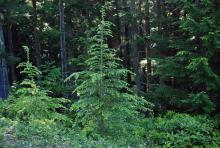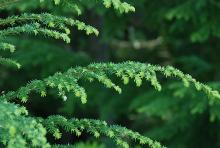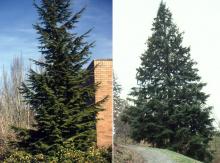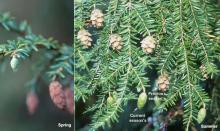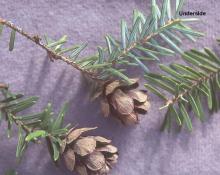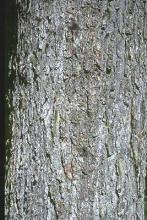Tsuga heterophylla
Common name:
Western Hemlock
Pronunciation:
TSOO-ga het-er-o-FIL-a
Family:
Pinaceae
Genus:
Type:
Conifer
Native to (or naturalized in) Oregon:
Yes
- Conifer, evergreen tree, 60-100(150) ft [18-30(46) m], narrowly pyramidal when young, pendulous branches. Needles in more or less 2 ranks, although arising from all around the stem, 5-20 mm long, equally broad from base to apex, rounded apex, finely dentate margin, very short petiole, shiny dark green and grooved above, with 2 broad whitish bands below with indistinct edges; persist 4-7 years. Cones elliptical, light brown, 2-2.5 cm long, each cone contains 30-40 seeds, small seed, only 2-3 mm long.
- Sun, but can take considerable shade.....for decades in a forest. When young, can be sheared into a hedge.
- Hardy to USDA Zone 6 Native range from southern Alaska along Pacific coast to California, also southeast British Columbia south in Rocky Mountains to Montana. There are few cultivars available in the nursery trade, possibly less than a half-dozen; in stark contrast to the large number of T. canadensis cultivars in commerce. One notable T. heterophylla cultivar is 'Thorsen's Weeping'.
- Western Hemlock is used in bonsai
- The small seeds can germinate and grow on a range of substrates; mineral soil, moss, decaying litter, or rotten stumps. The main requirement is that the rooting medium stay moist. It is not uncommon to find seedlings of Western Hemlock growing atop a fallen log ("nurse logs") or a rotten stump as much as 15 ft from the forest floor; when examined closely one will usually find one or more roots extending down into the moist soil. Over time the nurse log or stump decays away and the original root system is exposed.
-
It is not always easy to distinguish T. heterophylla from T. canadensis on branchlet characteristics alone. However, when comparing the lower side of the needles, T. canadensis has well defined narrow bands and a distinct green margin, whereas T. heterophylla has ill-defined broad bands and an indistinct green margin. Additionally, the buds of T. canadensis are ovoid and pointed, but those of T. heterophylla are globose.
- heterophylla: refers to the different sized leaves on the same twig, smaller toward the tip.
- Oregon State Univ. campus: south of Peavy Hall, along the service road.
Click image to enlarge

